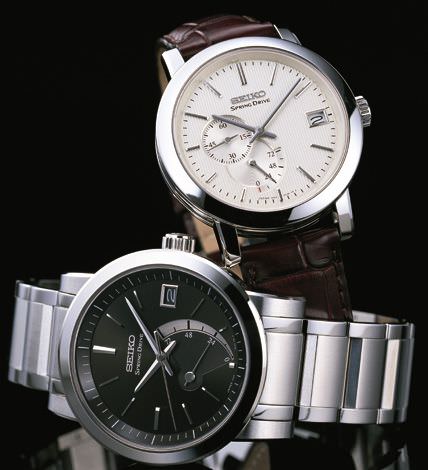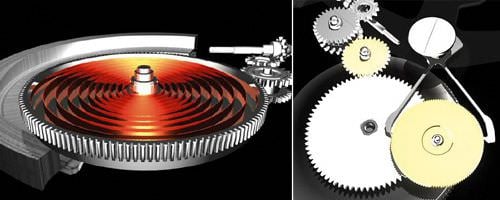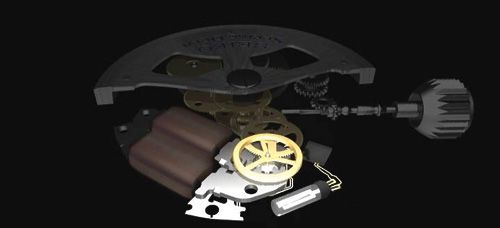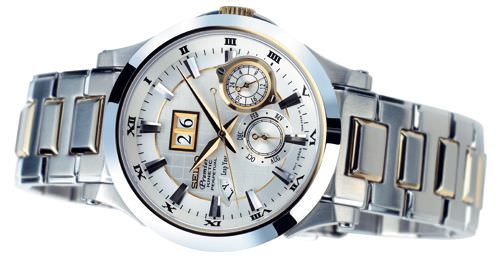In its effort to combine the precision of quartz and the energy autonomy of the mechanical watch, Seiko has been exploring two areas of research: the generation of energy by a mechanical rotor activating a quartz calibre (the Kinetic line of movements), and the technology known as Spring Drive.
It took 28 years for the brand to finally be able to mass produce and market the Spring Drive movement, initially designed by a Seiko engineer in 1977. The first functional prototype was presented in Basel in 1998. In the meantime, not less than 600 prototypes of 13 different generations were made leading up to the final version.

Spring Drive

The Mainspring & The Magic Lever

The Tri-Synchro Regulator
Everything begins with the spring
As its name indicates, the heart of this movement is the barrel spring. Seiko had already mastered this technology in 1959, but it needed to develop a new generation specifically for this movement, one made from a highly elastic material called ‘Spron 510.’ The result is a more powerful spring capable of delivering its energy in a more balanced manner over a longer period of time (72-hour power reserve). The spring is armed by a ‘Magic Lever’ fixed directly on the stem of the oscillating weight, thus allowing for better winding (30% more efficient) of the spring.
In this mechanism, it is what Seiko calls the ‘Tri-synchro regulator’ that replaces the escapement. It regulates three types of energy that are used by the movement: the mechanical energy produced by the barrel spring; the electrical energy created from the mechanical energy that activates a quartz resonator; and the electro-magnetic energy that drives the ‘glide wheel’ (literally a glide wheel but here a seconds wheel) to turn eight times a second (which causes a continuous motion of the hand, without visible jerks as in quartz watches).
The engineers at Seiko state that the movement generated inside the Spring Drive is unidirectional, thus eliminating friction due to two-way motion.
With its 276 component parts, of which 80 are found in the mechanical watch for its barrel spring, gear train, power reserve system and its Magic Lever, the Spring Drive thus has nearly all the characteristics of a mechanical timepiece, yet it attains the precision of quartz, which means it is accurate to plus or minus one second a day.
Superior finishing
Hand-assembled and finely finished by specialized watchmakers, with great attention to detail (30 jewels), the movements of the Spring Drive family represent a high stakes game for Seiko’s watchmakers, a fact admitted by the brand’s directors. “After 28 years of research and development, it is the beginning of a very important journey for Seiko, one that will continue to develop over the long term,” explains Robert Wilson, Director of Marketing for the international division of Seiko UK Ltd. To sum up, the Spring Drive venture is the departure point for “Seiko’s first really serious foray into the Haut de Gamme and Luxury sectors of the international watch market.”
The quality of the timepiece’s case clearly demonstrates the seriousness of the brand’s deliberate move upmarket. Endowed with solemn contemporary styling, composed of variations of the circle, the first watches in the Spring Drive family are imprinted with the most classic values of watchmaking.
Positioning itself on an equal footing with the Swiss
In its own way, the classic appearance of the Spring Drive watch bears witness to Seiko’s goal of positioning itself in the international Haut de Gamme (as it has been historically in Japan, with its special collections of mechanical watches, including grand complications).
Seiko’s affirmation of real timekeeping legitimacy (we must remember that Seiko has been in the business of measuring time for 124 years and has been making wristwatches for the last 92 years) coupled with its capabilities for research, innovation and development, have led the company to progressively introduce high level mechanical collections in the international marketplace. It is very clear now that Seiko, perceived for a long time as a ‘mid-range’ industrial brand, wants to assume an equal role with Swiss watchmakers.

Premier Kinetic Perpetual
The Premier collection
This gentrification of its offer can also be noted with the Premier collection, with 20 references, that will form the backbone of Seiko’s communication for 2005. The Premier is a classically styled watch that combines aesthetic refinement (at the risk of slightly overdoing it), advanced functionality, and technical innovation.
Equipped with movements from the Kinetic line, the Premier collection presents a major innovation: the Kinetic Perpetual movement.
This new calibre, made of 232 component parts, is also a cross between classic watchmaking and advanced micro-electronics (it houses the smallest ultrasonic motor in the world, with a thickness of 0.4mm). Powered by the movements of the rotor, it transmits this energy to 101 component parts in the gear train and the perpetual calendar, which itself does not require any correction before 2100.
The watch features a number of remarkable properties. It is equipped with a fully wound Auto-relay technology. It has six months of autonomy without being worn, and when placed into a sleep state, it keeps the exact time in its memory for four years, and then displays the current exact time when put back into use.
Seiko is opening new avenues in the realm of Haut de Gamme mechanical watchmaking, that itself has finally accepted the electronic hybrid. It seems to be a sort of pact between the 19th and 21st centuries.
Source: April-May 2005 Issue
More...Click here to subscribe to Europa Star Magazine.








